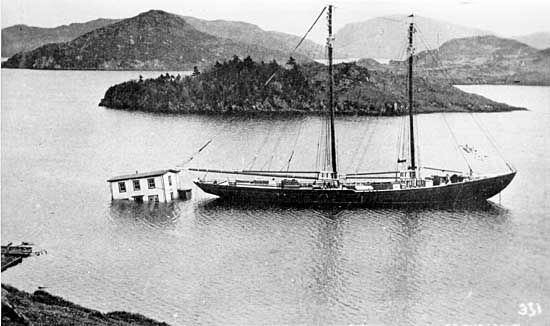
Earthquakes Are East Coast's Biggest Tsunami Threat

The U.S. East Coast's biggest tsunami threat lurks just offshore, according to research presented today (April 19) at the Seismological Society of America's annual meeting in Salt Lake City.
Recent earthquake swarms off the Massachusetts coast highlight the threat of tsunamis from nearby earthquakes, rather than faraway islands, said John Ebel, a seismologist at Boston College.
The geologic setting of the quakes off the Northeast appears similar to that of a magnitude-7.3 earthquake that struck in the Grand Banks off Newfoundland in 1929, Ebel said. The resulting 32-foot (10 meters) tsunami swamped southern Newfoundland and triggered underwater landslides that severed transatlantic telephone cables.
"We have to consider the possibility that there could be a Grand Banks-style earthquake in these areas and a tsunami that could affect the Northeast coast," Ebel told OurAmazingPlanet.
Ebel said that when he discusses tsunami hazards with emergency planners, many think the East Coast's biggest risk is from eruptions or underwater landslides at volcanic islands on the other side of the Atlantic Ocean, such as the Canary Islands.
The 1929 Newfoundland quake was felt from Canada to New York, across hundreds of miles. If a similar temblor were to hit under the seafloor today, residents would have 10 to 15 minutes of warning before a tsunami would clobber the coast, Ebel said.
Ebel has also found small earthquakes, in the magnitude-2 and magntiude-3 range, offshore as far south as southern New Jersey, he will report today at the meeting. The offshore rumbles indicate the areas most likely to have large, damaging earthquakes in the future, he said.
Sign up for the Live Science daily newsletter now
Get the world’s most fascinating discoveries delivered straight to your inbox.
That the offshore earthquakes mostly stop south of New Jersey is a surprise, Ebel said. Onshore, a powerful magnitude-7.3 earthquake hit Charleston, S.C., in 1886.
Although it's only a guess, Ebel thinks the increased seismicity from New Jersey to Nova Scotia could be related to changes that have occurred since the last Ice Age. For instance, the crust is flexing, now that its heavy load of ice and glacial lakes have disappeared.
"As soon as you get away from the glaciers, you don't have seismicity, but it could be a coincidence," Ebel said.
Researchers are also searching for signs of past tsunamis on the East Coast. A possible 2,400-year-old tsunami deposit has been found in New Hampshire, Ebel said.
Email Becky Oskin or follow her @beckyoskin. Follow us @OAPlanet, Facebook & Google+. Original article on Live Science's OurAmazingPlanet.

Most Popular





